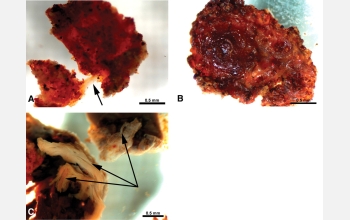Multimedia Gallery
After 70 million years, this T. rex soft tissue is still flexible and resilient.
Fragments of soft tissue extracted from the marrow cavity of a T. rex femur, after the surrounding bone mineral has been dissolved away. (A) The demineralized fragment is flexible and resilient and, when stretched (arrow), returns to its original shape. (B) Demineralized bone in (A) after air drying. The overall structural and functional characteristics remain after dehydration. (C) Regions of demineralized bone show fibrous material (arrows). Scale bars: 0.5 mm.
Credit: From Schweitzer et al., Science 307:1952-1955 (2005). Reprinted with permission from AAAS.
Images credited to the National Science Foundation, a federal agency, are in the public domain. The images were created by employees of the United States Government as part of their official duties or prepared by contractors as "works for hire" for NSF. You may freely use NSF-credited images and, at your discretion, credit NSF with a "Courtesy: National Science Foundation" notation.
Additional information about general usage can be found in Conditions.
Also Available:
Download the high-resolution JPG version of the image. (453 KB)
Use your mouse to right-click (Mac users may need to Ctrl-click) the link above and choose the option that will save the file or target to your computer.
Related story: T. rex Fossil Yields Soft Tissue



